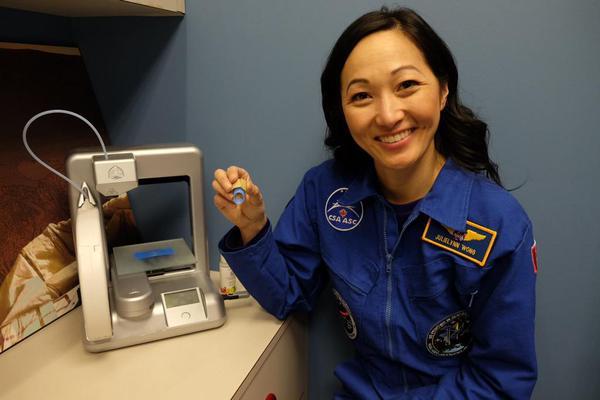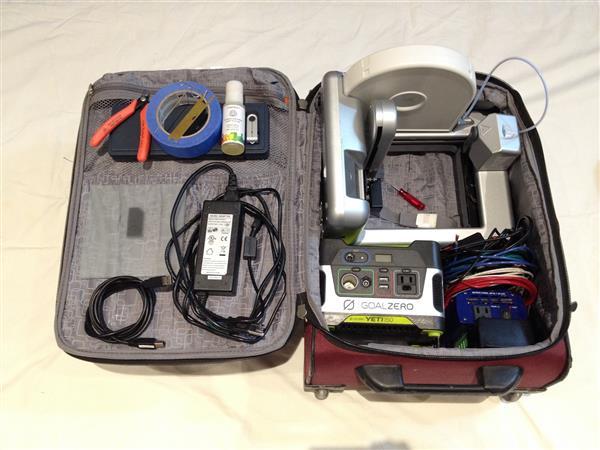 In July 2014 we reported on the innovative work of Toronto, Canada-based Dr. Julielynn Wong, the Harvard-educated physician who, along with other researchers, conducted a study of the feasibility of 3D printing surgical instruments. The underlying idea was to make it possible for the instruments to be printed only on an as-needed basis, thereby reducing the volume of supplies taken on space missions, for instance.
In July 2014 we reported on the innovative work of Toronto, Canada-based Dr. Julielynn Wong, the Harvard-educated physician who, along with other researchers, conducted a study of the feasibility of 3D printing surgical instruments. The underlying idea was to make it possible for the instruments to be printed only on an as-needed basis, thereby reducing the volume of supplies taken on space missions, for instance.
Indeed, Dr. Wong specializes in, says the website of her company 3D4MD, “3D printing medical devices in austere environments.” When they say “austere,” they aren’t exaggerating–as she was the first person to “3D print medical supplies at the Mars Desert Research Station.” In the interest of making the latest in lifesaving technology to even the most remote regions of the Earth, Dr. Wong designed a 3D printer that is solar powered and small enough to be easily transported.
Dr. Wong recently conceived of a way to 3D print custom finger splints for a common hand injury called “mallet finger.” There are actually multiple names for mallet finger–”baseball finger,” as when you attempt to catch a baseball and jam your finger, “dropped finger,” and “dolphin finger,” among others. More generally, the injury that results in mallet finger is called “extensor tendon injury. When one of your fingers is extended, meets with blunt force (with a baseball or anything else), and gets jammed, the result is a ruptured or stretched extensor digitorum tendon, which runs through the hand into the wrist and up the arm.
Patients with mallet finger cannot extend the affected finger and they also experience numbness and pain. If the injury is really severe, the patient receives medication for pain and to prevent infection. Mallet finger is most often treated without surgery and primarily with a splint. For most patients, the splint must be worn for six to eight weeks and works to help the tendon return to its normal length prior to the injury.
 While mallet finger is a common injury, if it goes untreated it can be quite debilitating. Getting access to treatment if you live in a remote area is obviously challenging, which is why Dr. Wong has created 3D4MD–to assist medical practitioners who provide health care in out-of-the-way places in providing their patients with the best of care. Typically, if you live far from access to necessities like medical clinics, you will also pay considerably more for treatment. However, with the 3D printing of medical supplies on demand, health care practitioners don’t need to try to anticipate every single need of their patients. When a need arises, clinical staff can use the solar powered 3D printers to create an array of devices and instruments like the finger splint.
While mallet finger is a common injury, if it goes untreated it can be quite debilitating. Getting access to treatment if you live in a remote area is obviously challenging, which is why Dr. Wong has created 3D4MD–to assist medical practitioners who provide health care in out-of-the-way places in providing their patients with the best of care. Typically, if you live far from access to necessities like medical clinics, you will also pay considerably more for treatment. However, with the 3D printing of medical supplies on demand, health care practitioners don’t need to try to anticipate every single need of their patients. When a need arises, clinical staff can use the solar powered 3D printers to create an array of devices and instruments like the finger splint.
Dr. Wong explained in this regard:
“To have a custom mallet finger splint made by a hand therapist a patient usually has to cover the hand therapist’s labor time as well as the material costs. The material cost of 3D printing is half the material cost of making a mallet splint with a hand therapist. And, 3D printing custom mallet splints saves labor time because you’ve automated part of the splint-making process.”
In her video concerning the custom finger splints, Dr. Wong explained the philosophy behind 3D4MD’s efforts. Not only is the company concerned with providing for the medical needs of patients who don’t have ready access to care because of their locations, but they also want 3D printing to be a major tool in providing that kind of thorough health care even in the most remote of areas. Getting the solar-powered 3D printers out to providers in, for instance, rural Canada, allows them to help their patients in a much more immediate way.
She used a familiar saying to elucidate further:
“There’s a saying that if you give a man a fish, you feed him for a day; if you teach him how to fish, you feed him for a lifetime. When doctors join humanitarian medical missions, it’s often only a temporary solution, but now if mission staff take two solar-powered 3D printers with them, they can leave them behind after teaching the clinic staff how to print their own medical supplies.”
See Dr. Julielynn Wong’s 3D4MD website for more information on the company’s past and current projects, including 3D printing personalized assistive devices for people with disabilities, the solar-powered 3D printers, and much more. What are your thoughts on 3D printing with solar power? Let us know in the Solar Power forum thread on 3DPB.com.
Subscribe to Our Email Newsletter
Stay up-to-date on all the latest news from the 3D printing industry and receive information and offers from third party vendors.
You May Also Like
IperionX Inks 10-Year Deal with Wisconsin Manufacturer for 80 Metric Tons of Titanium Per Year
IperionX, the Charlotte-based supplier of sustainable titanium powders used for additive manufacturing (AM) and metal injection molding (MIM), has signed a ten-year deal with United Stars, a group of industrial...
Gastronology Launches Industrial Production of 3D Printed Food for Dysphagia Patients
Food 3D printing has, in many ways, been an additive manufacturing (AM) segment looking for the right business case. While some applications are beautiful and others may or may not...
Lockheed Martin Leads $3M Investment in Q5D’s Electronics 3D Printing System
Q5D, an original equipment manufacturer (OEM) of robotic arm, hybrid additive manufacturing (AM) systems used for wire harness production, has closed a $3 million investment round. The investment arm of...
3D Printing News Briefs, April 6, 2024: Depowdering, Cybertruck Door Handles, & More
In today’s 3D Printing News Briefs, ioTech’s digital manufacturing CLAD technology is opening up opportunities for microelectronics and additive manufacturing. Hexagon and Raytheon Technologies commercially released the Simufact Additive Process...

































